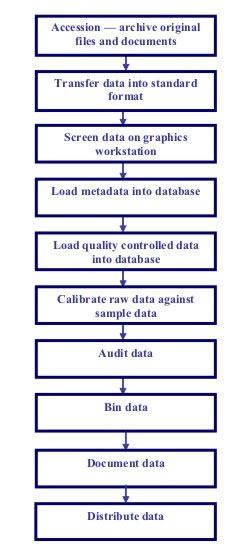- Submit data
- What do we do with your data
- Data processing steps
- CTD data processing
CTD data processing

CTD instruments measure conductivity, temperature and depth, along with other parameters. The sensors are mounted in a frame or rig. The rig often has bottles attached which are used to collect water samples during a deployment or cast.
BODC's current procedure for processing CTD data is
1. Archive original data. When the data are first received they go through our Accession procedure. The data are securely archived in their original form along with any associated documentation.
2. Transfer data to standard BODC format. Data are converted to BODC standard units. Codes are assigned to each parameter. Equipment manufacturers' calibrations are applied.
3. Screen data using interactive visualisation software. Suspect values are flagged. Bottle firing depths are identified. Start and end of good data are selected.
4. Load metadata (data about data) into the database. This includes date and time of collection, position, CTD type, bottle information and rig geometry.
5. Load quality-controlled data into the database.
6. Calibrate raw data against sample data.
7. Audit data. The data are audited by a different member of staff to check that no errors have been made.
8. Bin data. Data samples are usually averaged to one decibar for shallow casts or to two decibars for deep casts, unless a different data resolution is required by the project scientists.
9. Document data. Documentation contains information about instruments, calibration, sampling techniques, parameters and sea areas.
10. Distribute and deliver data.

